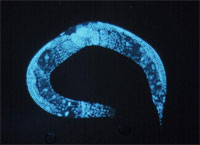Researchers Identify microRNA Targets in C. elegans
January 11, 2010
Media Contact: Debra Kain 619-543-6163

Biologist Amy Pasquinelli and colleagues have determined a way to match microRNAs to their targets in C. elegans, a model organism for genetic study.
Credit: National Human Genome Research Institute
MicroRNAs (miRNAs) are non-coding RNAs that impact almost every aspect of biology. In recent years, they have been strongly implicated in stem cell biology, tissue and organism development, as well as human conditions ranging from mental disorders to cancer. For the most part, miRNAs control gene expression of messenger RNA (mRNA) targets. Unlike mRNAs, which are translated into proteins, miRNAs function as short, untranslated molecules that regulate specific mRNAs through base-pairing interactions. Since miRNAs bind limited stretches of consecutive bases in mRNAs, identifying which mRNAs are targets of individual miRNAs has been a bottleneck of biomedical research, as researchers have had to rely largely on computational predictions.
Now, researchers at the University of California, San Diego have identified the binding sites of these miRNAs in one of the foremost model organisms, C. elegans, using biochemical means to capture targeted mRNA sequences in vivo.
Argonaute proteins are key players in gene-silencing pathways; miRNAs are anchored into specific binding sites to guide Argonaute proteins to target mRNA molecules for silencing or destruction. By cross-linking interactions between the Argonaute protein bound to miRNA and mRNA duplexes, principal investigators Gene Yeo, PhD, assistant professor in UCSD's Department of Cellular and Molecular Medicine and Amy Pasquinelli, PhD, associate professor in UCSD's Division of Biological Sciences, were able to globally identify their specific binding sites in the nematode.
"Our results were very surprising in that we discovered that individual miRNAs can interact with their targets very differently, and differently than we had expected," said Yeo. "This approach, and the computational analyses that were develop, open up new ways to identify individual miRNA targets in any tissue and cell type in almost any organism."
"The revelation of thousands of endogenous miRNA target sites provides an unprecedented wealth of data for understanding how miRNAs regulate specific targets in a developing animal," added Pasquinelli.
Their work was published online in advance of print on January 10 by Nature Structural & Molecular Biology.
